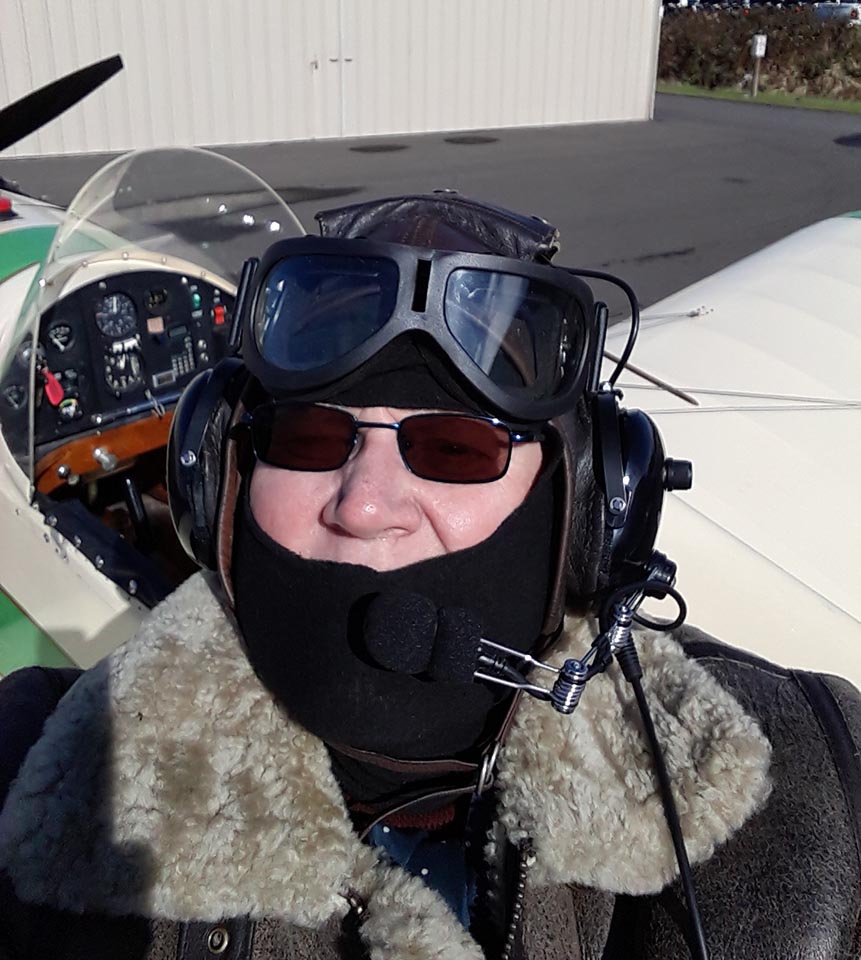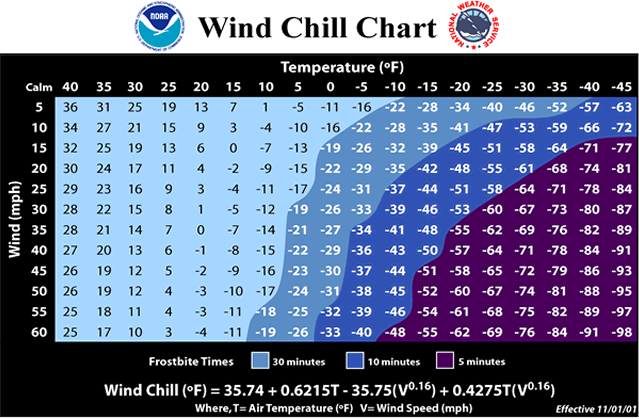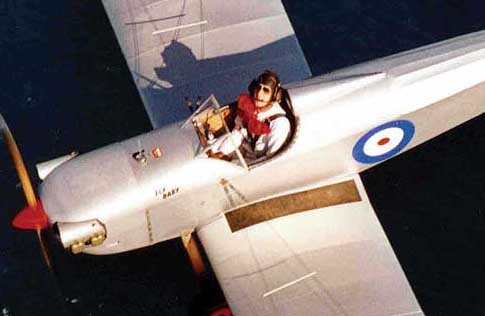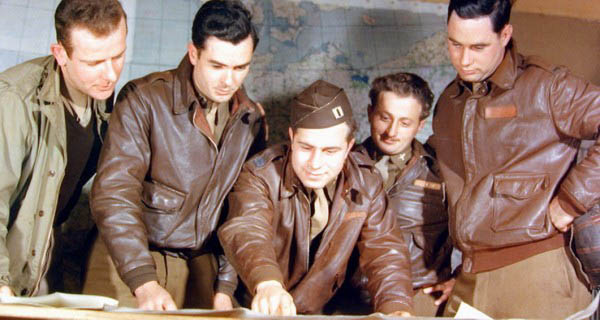
Y'see, these days, most people aren't that familiar with discomfort when it gets chilly. They go from a warm house to a soon-to-be warm car, walking in to a warm job site or store. Typically, a light jacket over typical winter indoor wear is all they *really* need; a brief exposure to the cold outdoors only makes arrival at the destination even more welcome.
Sure, some folks work outside and have to learn how to bundle up. But it's not the same as flying an open cockpit airplane.
What's the difference? The slipstream. You're probably familiar with the concept of "Wind Chill Factor." It's basically an guide as far as how fast heat is leaving your body.
Wind Chill Factor
To understand how Wind Chill works, start with an inanimate item, like a brick. It's a nice day, and your shop is at 70 degrees (Fahrenheit). You put the brick in an oven, heat it up to various temperatures, and record how much time it takes for the brick to cool to ambient temperature.| Brick Starting Temperature |
Time to Cool to 70 Degrees |
| 100° |
60 minutes |
| 90° | 45 minutes |
| 80° | 30 minutes |
Heat the brick up to 100° again, but this time, set it on the table with a fan blowing on it. If the brick takes only 45 minutes to cool, it's just like the temperature was 90 degrees instead of 100. So the "Wind Chill Factor" is the temperature that took 45 minutes to cool WITHOUT the fan: 90 degrees.
And, of course, the amount it time it takes the brick to cool depends on how big a fan is blowing on it...in other words, the wind speed. The key point to remember is that using the fan will NEVER reduce the brick's temperature to less than 70 degrees (the ambient temperature). You need something to actually cool the air if you want a lower temperature than ambient...that's where "air conditioners" come in.
Wind Chill is not really a "Temperature"...it's an indication of how fast heat is getting sucked away. It's the reason that 70 degree air feels comfortable, but you'll die if you stay in 70 degree water too long. The water is more efficient at taking heat from your body than air is, although wind improves the efficiency of the air.
Wind Chill and the Human Body
If the wind can't actually lower the temperature past ambient, why do we worry about wind chill? "I'm comfortable enough with a light jacket when it's 50 degrees out there, why am I so bloody cold if I go flying with just that jacket?"It's all because you're warm blooded. Your body has evolved to operate the best with an internal temperature of about 96 degrees. It burns food and fat to keep the temperature that high. Put you on an iceberg in your skivvies, and your body will start shivering, using muscles to generate heat. You body will try to maintain that core temperature by reducing blood flow to your extremities to try to keep your head and torso as warm as it can... and your hands and feet get cold. Eventually, of course, you'll die. Not by "freezing to death," but by having your core temperature reduced below 80-90 degrees. You'll be dead, even if your brain and body are still "room temperature."
Let's examine this. Say we want our brick in front of the fan to stay at a nice, toasty, 100 degrees. So we wrap it with a tiny electric blanket, and connect the blanket to a battery with a rheostat that sets how much power goes into the blanket. And, with the same fan running, we measure how much power it takes to maintain the brick at a given temperature:
| Desired Brick Temperature |
Electric Blanket Power |
| 100° |
5 Watts |
| 90° | 4 Watts |
| 80° | 3 Watts |
Your body is the "brick." It's trying to maintain a temperature of 98.6° all the time. It burns energy to do that (either in the form of food or your stored fat), and the colder it gets, the more energy it has to burn. That's where the Wind Chill tables come from. It's an indicator of how much your body has to work to maintain its core temperature, given an ambient temperature vs. the wind speed.

The Lesson About Wind Chill
OK, what does the above tell us about keeping warm in a Fly Baby.You might say, "Hey, the windshield shields me from the wind. So what does Wind Chill have to do with it?"
No joy, pilgrim. Take a look at this illustration...it shows the wind flow past the windshield. It circles BACK and catches you from behind! From there, it enters a sort of vertical eddy right behind the windshield.
No question about it, the cockpit eddy is a gentle zephyr compared to the main slipstream. But it IS moving air...which means you'll get wind chill effect.
 And look at our steely-jawed aviator in the
above drawing. Notice how his neck is fully exposed to
that tumbling draft. Going to get a mite cold, won't
it, unless the temperature is high enough that it's
comfortable.
And look at our steely-jawed aviator in the
above drawing. Notice how his neck is fully exposed to
that tumbling draft. Going to get a mite cold, won't
it, unless the temperature is high enough that it's
comfortable.This picture of Bob Grimstead flying his "Bristol Balderdash" Fly Baby illustrates the airflow issue. What's that red thing in front of him? His scarf. If you want the scarf to stream out dramatically behind, you need to physically put the end of the scarf OUTSIDE the cockpit eddy.
A Warning for Non-Fly Baby Pilots
Note on a Fly Baby, the effect of the "cockpit eddy" is pretty much restricted to the upper torso. The forward portion of the cockpit in a Fly Baby is pretty well enclosed, and there's not much of a draft in there.NOTE THAT THIS IS NOT THE CASE FOR TWO-SEAT OPEN COCKPIT AIRPLANES! Especially biplanes!
Why not? Because a second cockpit gives a place for the air to rush IN, and another place for it to rush out!
I was flying my Fly Baby a long time ago, on a moderately cool winter day (here in Seattle, that means in the mid '40s). After I landed my friend Stan Brown offered me a ride in the front cockpit of his Stearman. I wore my Fly Baby togs....and almost froze to death.
There was a HUGE vertical draft out of the front cockpit. I believe the upper wing deflected the prop wash into the rear cockpit where it shot forward and came out in the front cockpit. Look at this picture...does Stan look comfortable to you?

The First Lesson
Remember....if the air is cold, or even cool, ANY bare
skin is going to be susceptible to any draft. The
pictures show how a scarf is going to be a real advantage
when the temperature goes down. But the same is true
for ANY part of your body. Your neck, your hands,
your arms if you don't keep the breezes out.
Now, this doesn't mean you have to wrap up like the
Michelin man for every flight. It's just that you
have to pick your open-cockpit wear with some
consideration as to the expected temperature and the
planned duration of your flight. I provide some
advice along these lines, included in the Graphic Guide at the tail
end of this posting.
The Second Lesson
Commensurate with protecting your bare skin from direct
air contact is the ability of whatever you're wearing to
keep the cold out.
A number of years back, I went flying with another Fly
Baby owner. When we got to the destination, he was
hunched over, shivering. I was just fine.
The difference was our coats. He was wearing a
heavy coat. A heavy CLOTH coat...wool, I
think. I was wearing my standard A2 flight jacket.
Insulation works by trapping air and letting your body
heat warm it up. But if you wear wool on the
OUTSIDE, the air it tries to trap is continually replaced
with new cold air.
The difference (again, depending on whether it's actually
cold or not) is that your outer clothing must be
windproof. That's where leather excels. The
cold air may make the outside of the leather cold, but the
cold air itself doesn't penetrate.
Now...it doesn't HAVE to be a leather coat. Hans Teijgeler flies his Fly Baby in
Holland, where it does get nippy in the winter. He
wears an MA-1 flying jacket; the USAF's nylon-shelled
flight jacket first introduced in the 1950s. The MA-1
has several factors going for it. Te nylon
does pretty good at keeping the wind out, there's
good, modern insulation,
the knit bottom keeps drafts from coming from
below, and the cut of the jacket makes it less
likely to snag when sliding into the
cockpit. It's also less bulky that the
heavy-duty leather coats like the Irwin jacket
or the B-3.
I
like the look of leather flying coats...but,
certainly, if you've got something that'll keep
the wind out, go for it. Make sure it had
knit sleeves, though. Open sleeves can act
like funnels to bring cold air inside the coat.
But
don't... DO NOT...just put on a sweater or
sweatshirt without anything over it and expect
to be comfortable. You need the windproof
exterior.
For
more information on leather flying gear, see my
"Leather Jackets for the
Open-Cockpit Aviator."
The Third Lesson
The third lesson comes out of the second: Insulate as needed, under your external coat. You can wear the warm stuff...wool, flannel, etc...under a good windproof coat.A lot of folks don't realize that the original A-2 leather flying jacket was NOT insulated. It had a leather exterior, and a cloth liner, and that's it. Back when the A-2 came out, the pilots of the Army Air Corps wore wool uniforms. They could throw on that uninsulated jacket atop their uniforms and, for the most part, be warm. You can tell tht jackets are uninsulated from original pictures like the one below. Notice how the jackets aren't bulky at all.

Helmet
Flying helmets are used for two
things: Keeping the cold air off your head, and
providing attachment points for your headset and goggles,
if worn.
The Swiss have a saying: "If your feet are cold,
put on your hat." There are a TON of blood vessels
running through your scalp to keep the brain at proper
temperature. If you let your head get cold, the rest
of your body will follow.
If the weather is really warm, I may not wear a helmet. But unless it's in the 90s, I do.
Three basic options: Cloth, Leather, and Shearing.
Leather and cloth helmets are usually the same style,
except for the material. Leather is more windproof,
of course, so I recommend leather. If you live in a
warm climate, with not much opportunity to fly in cold
weather, a cloth one may be the right pick.
Shearling helmets are basically the skin of a sheep, wool
attached, turned inside out. That's a shearling
helmet on the right. I'd make this a last pick; buy
one if you try flying in the winter and are just too
cold. Otherwise, skip the shearling.
When you buy a helmet, you need to decide if you want the
kind that works with a radio headset. I figure a
headset is worth 10-30 degrees of warmth, right there.
More information on my Helmet
page.
Accessories
Your face is exposed to the cockpit eddy, too. I
have a spandex balaclava that fits nicely under my flying
helmets, and keeps my face comfortable. Wool ski
masks would work, too. Fortunately, the cockpit eddy
doesn't seem that strong at the face.
In the colder weather, you'll definitely need a
scarf. Not only does it protect your bare neck, it
keeps drafts from shooting down the back of your jacket
(yow!). See my scarf page
for more information.
Don't forget gloves! I have a common set of leather
gloves for most flying, but a set of ski gloves for when
it gets cold. Very cold-weather gloves should be
long enough to go over your jacket cuffs and keep your
wrists warm.
When it gets really cold, thermal underwear provides a
nice extra layer.
For the most part, my flying in done in ~20° F weather
and I don't worry much about my feet. Heavy socks,
but usually wear regular shoes. Again, though, the
Fly Baby is pretty sealed up forward....if you're flying
something else, you might need better protection to your
feet.
Other Fly Baby guys have suggested other
approaches. Drew Fidoe runs a "trunk" from the
aircraft heater and tucks it into his flying suit.
He also suggests chemical hand-warmers. Another
person point out that there are electric suits for
motorcycle riders that might work as well.
A Graphic Guide
Sometimes, it's easier to just look at a graphic.This one summarizes my decision process when taking my Fly Baby for a flight. You'll see some overlap; a lot of times, my decision depends on how cold or warm I've feeling before takeoff.
This guide is based upon what I'd need for one of my typical wintertime flights, for about 45 minutes. If I'm actually flying somewhere, and will be aloft longer, I assume the perceived temperature will be five to ten degrees colder.
Note that YOUR TOLERANCE MAY BE DIFFERENT. So adjust the above, based on your own experience.
A Final Note
How can you tell if you're dressed adequately for the
flight? In my case, for cold weather flights, if I'm not
sweating a bit after climbing into the airplane and strapping
in....well, I'm probably underdressed.
 Return to the Stories Page
Return to the Stories Page